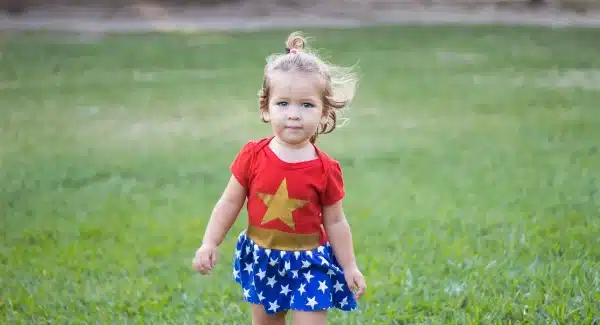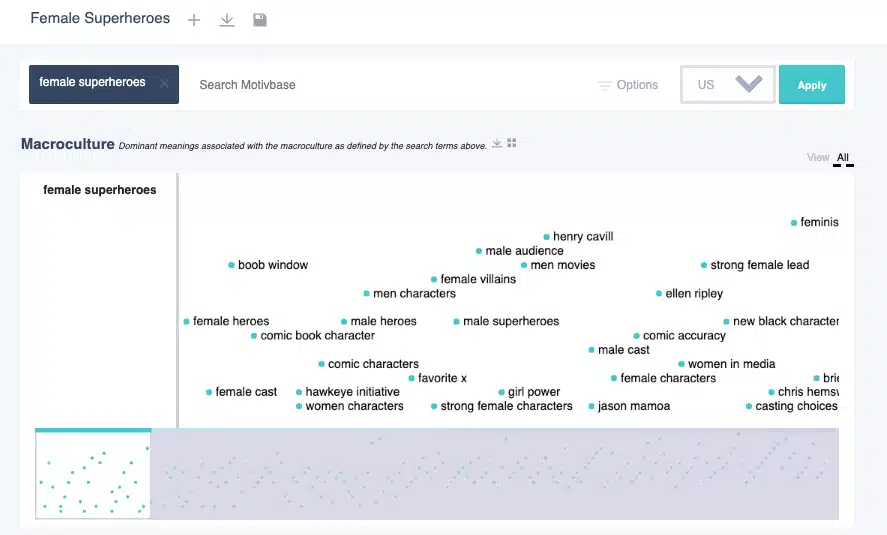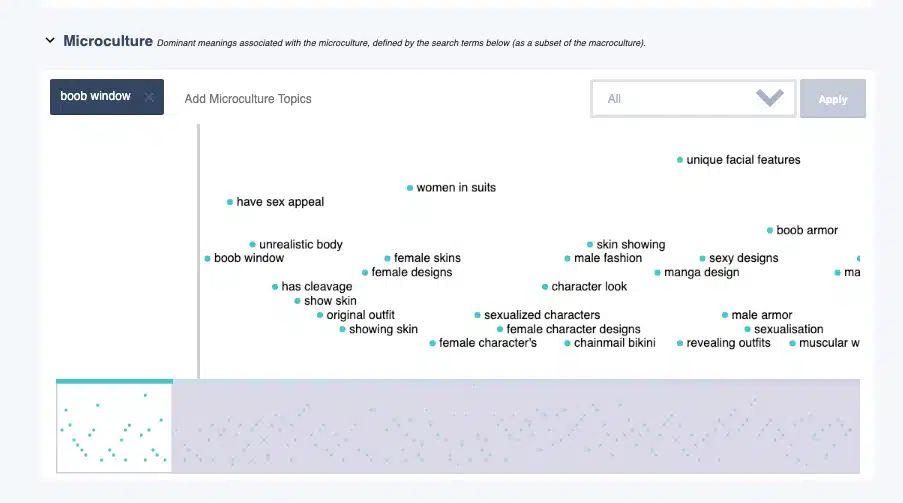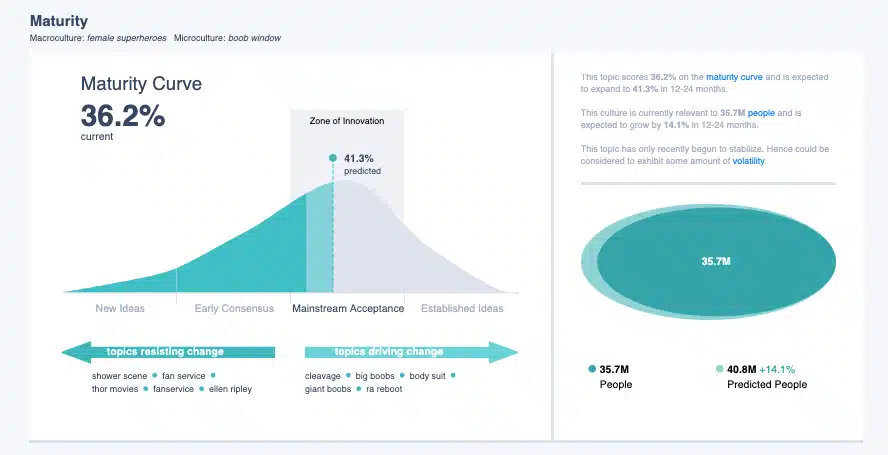Understanding the Boob Window
By:
EVP & Group Director, Anthropology
Read the Full Article
How are consumer expectations for female superheroes changing?
 For decades, the superhero universe has been dominated by men. Male characters have been thrust into the limelight, while female characters have been leveraged as supporting roles, or mere victims for our caped crusaders to save time and time again.
For decades, the superhero universe has been dominated by men. Male characters have been thrust into the limelight, while female characters have been leveraged as supporting roles, or mere victims for our caped crusaders to save time and time again.
Recently a shift in culture has led to more gender representation amongst superheroes, specifically in film. Captain Marvel and Black Widow have had their own blockbusters produced in the Marvel universe. Wonder Woman and Harley Quinn have become lead characters in multiple DC movies.
While the media has largely focused on troll culture (especially during the casting of Brie Larson as Captain Marvel and that film’s subsequent launch), we here at MotivBase were curious if this type of thinking was as dominant as social media and the news would have us believe.
Or was there something deeper and more meaningful hiding behind all the chatter?

Thank you!
Understanding the Boob Window
By:
EVP & Group Director, Anthropology
Read the Full Article
How are consumer expectations for female superheroes changing?
 For decades, the superhero universe has been dominated by men. Male characters have been thrust into the limelight, while female characters have been leveraged as supporting roles, or mere victims for our caped crusaders to save time and time again.
For decades, the superhero universe has been dominated by men. Male characters have been thrust into the limelight, while female characters have been leveraged as supporting roles, or mere victims for our caped crusaders to save time and time again.
Recently a shift in culture has led to more gender representation amongst superheroes, specifically in film. Captain Marvel and Black Widow have had their own blockbusters produced in the Marvel universe. Wonder Woman and Harley Quinn have become lead characters in multiple DC movies.
While the media has largely focused on troll culture (especially during the casting of Brie Larson as Captain Marvel and that film’s subsequent launch), we here at MotivBase were curious if this type of thinking was as dominant as social media and the news would have us believe.
Or was there something deeper and more meaningful hiding behind all the chatter?
As we will see, there is a culture shift underway challenging the toxic masculinity that has been associated with hero culture in the past.
To explore this area, we used our MotivBase Trends Platform to explore the culture of female superheroes.

Naturally the tension of female heroes being compared to their male counterparts. But as we can see in the screenshot from our platform posted above, there is also a direct association with the culture of female superheroes and the desire for strong female characters.
Consumers are linking this culture with how comics treat women, how movies approach building a female cast, and how females are not just underrepresented as heroes, but also as villains in film.
But perhaps most interesting is the association consumers are making to the role of how female superheroes are physically portrayed and how their costumes often hypersexualize the character.
This is captured in the topic “Boob Window”.
A Boob Window is a hole in clothing or a female superhero’s costume that shows a woman’s cleavage. It can appear on the front of the chest or on the side, but the intent is to make the costume more revealing.
In order to better understand why the topic or meaning behind the boob window is so dominant, we double-clicked into this culture.

As we can see in the topic universe, this is not a “troll” championing the sexualization of female super characters.
In fact, it is the opposite.
The Boob Window is a cultural artifact being used by consumers to say that the superhero genre needs to be more respectful of its depictions of women.
Consumers are increasingly contemplating the unrealistic body images that can be found in superhero universes. The purpose behind why a costume is designed a certain way is being discussed. And consumers are more readily comparing the way we treat female heroes to how we treat their male counterparts.
Perhaps, most interestingly, true comic aficionados are rejecting when a film adaptation sexualizes a female character’s outfit, and deviates from an original comic design that didn’t showcase that character’s breasts. One example of this is the choices made during the movie X-Men Apocalypse when Olivia Munn’s costume for her character Psylocke added a Boob Window to the already revealing original design.
When we turn to what is motivating this shift in culture, we can see that consumers want to be seen as someone who has the desire and ability to succeed in life. And they are not afraid to work hard, as they believe that this effort will be rewarded with positive outcomes.

But we can also see that this desire for a more balanced approach to how female superheroes are portrayed is intrinsically linked to how women are portrayed in the beauty industry and by a growing awareness of how patriarchy has driven unhealthy and unrealistic expectations for women.
What does this tell us about the future?
First, it points to a push toward more equality in the universes of superheroes. Old tropes are being challenged, and expectations are being reset.
Secondly, this push towards a more body-positive approach to the female form and femininity is not just taking place as consumers consider the female superhero. This trend is emerging in the retail landscape, the fashion industry, and (as we mentioned) in beauty.
Cultures are not isolated and distinct. They intersect and impact each other.
We anticipate this trend will only grow with time.

As we can see in the chart above, the culture is currently relevant to 35.7 million people but is predicted to grow by more than 14% in the next 12-24 months.
Conclusion:
While we often are distracted by the loudest voices on social media or the latest topic to trend on Twitter, we have to remind ourselves that a lot of chatter does not, a trend make.
In order to understand if something is consistently growing in importance in culture, and is likely to have a long-term impact on how we think, we need to go beyond what is being said to explore why things are being expressed.
As we can see with something as specific as the boob window, there is something deeper transpiring than the mere talk of cleavage. It is a shifting expectation that women deserve more respect.
As parents introduce superheroes to their children, they are more aware of how this sexualization has a negative impact on self-esteem.
As more women become fanatics of the Marvel and DC universe, they start to expect their heroes to be treated with equal respect to how male heroes would be treated. Because that is a fantasy, they want to also see transpire more in the real world.






